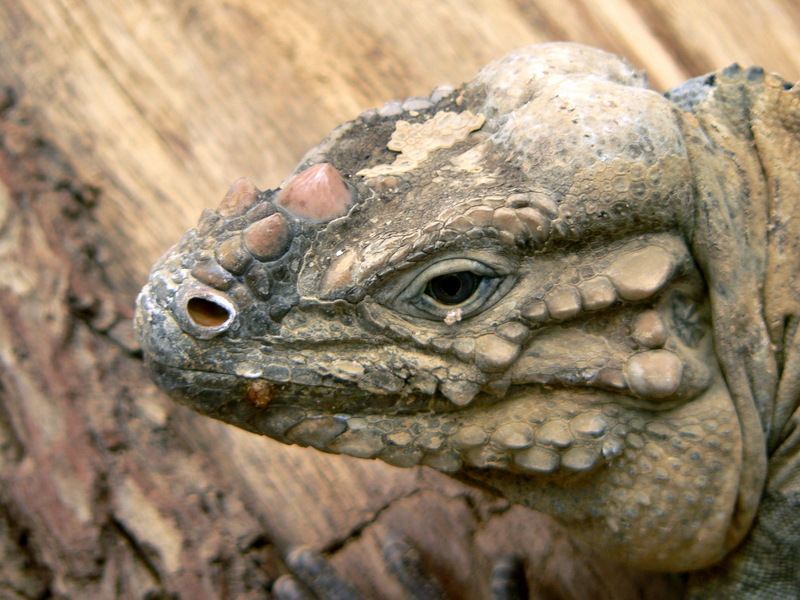Rhinoceros Iguana (Cyclura cornuta) - Wiki Rhinoceros Iguana
From Wikipedia, the free encyclopedia
[Photo] Rhinoceros Iguana (Cyclura cornuta) at Frankfurter Zoo, Germany. Date 07.07.2007. Photographer: Frank C. M??ller (http://commons.wikimedia.org/wiki/User:Frank_C._M%C3%BCller)
The Rhinoceros Iguana (Cyclura cornuta) is an endangered species of lizard of the genus Cyclura that is primarily found on the Caribbean island of Hispaniola, shared by the Republic of Haiti and the Dominican Republic. They vary in length from 2 to 4 1/2 feet and skin colors range from a steely gray to a dark green and even brown. Their name derives from the fact that the reptiles possess a bony-plated pseudo-horn or outgrowth which resembles the horn of a rhinoceros.
Taxonomy
The Rhinoceros Iguana is a species of lizard belonging to the genus Cyclura. Its first Latin name Cyclura is derived from the Latin words meaning "circular" and "tail" due to the thick, ringed tail characteristic of all Cyclura iguanas. The Rhinoceros Iguana's second Latin specific name, Cornuta, derives from the horned projections on the snouts of males of the species. The species was first identified by Pierre Joseph Bonnaterre in 1789.
There are two subspecies of Cyclura cornuta, the Mona Ground Iguana(Cyclura cornuta stejnegeri) and the Navassa Island Iguana(Cyclura cornuta onchiopsis), although the latter species is believed to be extinct in the wild.
Anatomy and morphology
The Rhinoceros Iguana, like other iguanas of the genus cyclura is a large bodied, heavy headed lizard with strong legs and a vertically flattened tail. A crest of pointed horned scales extends from the nape of their neck to the tip of their tail. Their color is a uniform gray to olive drab. Males possess bony prominent turbicles on their snouts resembling horns, an adipose pad in the form of a helmet on the occipital region of the head, and a large dewlap. Males of this species, like other species within the Genus Cyclura, are larger than females, and have more prominent dorsal crests and "horns" in addition to femoral pores on their thighs, which are used to release pheromones. Females lack these pores and have shorter crests than the males, making the animals sexually dimorphic.
Distribution and habitat
Ranging throughout Hispaniola, Haiti and the Dominican Republic; Rhinoceros iguana populations are stable only on Isla Beata and the extreme of the Barahona Peninsula inside Parque Nacional Jaragua. There are moderately dense populations in the southeastern region of Haiti and its offshore islands including the saltwater lake of Etang Saumatre. Populations in Haiti are even more endangered due to the deforestation and human clearing practices. In general, the iguanas are found most abundantly in, although not restricted to, scrub woodland, dry forests characterized by xeric, rocky habitats of eroded limestone in coastal terraces and lowlands of the mainland and several offshore islands and small cays in a variety of subtropical life zones and habitat types.
The Rhinoceros Iguana is a diurnal species living primarily in rocky outcroppings with little vegetation for cover. Although quick to flee when attacked or threatened, they will aggressively attack by biting and repeatedly striking with their thick tail if cornered.
Diet
The Rhinoceros Iguana is a primarily herbivorous species like other Cyclura. Their diet often consists of fleshy fruit, leaves, and berries. However, Rhinoceros Iguanas have been known to eat small lizards, snakes, and insects.
Mating
Rhinoceros iguanas, unlike other members of the genus cyclura, reach sexual maturity at four to five years of age. Females become sexually mature at 2-3 years of age. Male Rhinoceros iguanas are territorial and the most aggressive male will have the largest range of territory. Mating takes place at the beginning of, or just prior to, the first rainy season of the year (May to June)) and lasts for two to three weeks. Females lay from 2 to 34 eggs, with an average clutch size of 17, within 40 days. Females guard their nests for several days after laying their eggs, and incubation lasts approximately 85 days. It has been noted that their eggs are among the largest lizard eggs produced in the world.
Endangered status
Although Rhinoceros iguanas are the most common rock iguana kept in captivity there remain approximately 10-16,000 of these animals in the wild. A successful breeding program existed at the Parque Zool??gico Nacional of the Dominican Republic (ZooDom) from 1974 to 1994, with an average of 100 babies hatching annually. These efforts included reintroductions of captive-bred "head-started" young to several protected areas in the southwest Dominican Republic in order to reduce the odds of predation by snakes and feral animals such as mongoose or cats. The program has not continued since 1995, due to an administrative change at the zoo.
Captivity
The Rhinoceros Iguana is well established in captivity, both in public and private collections. Rhinoceros iguanas in captivity throughout the United States totals 393,236 individuals at 20 zoological institutions, with an additional 533 animals of unassigned subspecies, reported by seven American Zoological and Aquarium Association institutions. The actual number may be much higher considering animals kept at European and Asian zoos and the many kept as pets in private collections. As a result, the demand for wild-caught animals to supply zoos and the pet trade has been reduced.
Despite these numbers, making them also the most numerous species of Cyclura, they are still considered a CITES (Convention on International Trade in Endangered Species) protected animal.
http://en.wikipedia.org/wiki/Rhinoceros_Iguana
| The text in this page is based on the copyrighted Wikipedia article shown in above URL. It is used under the GNU Free Documentation License. You may redistribute it, verbatim or modified, providing that you comply with the terms of the GFDL. |
